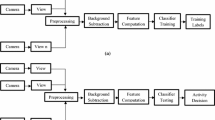Abstract
We present a method to recognize gestures made by Chinese traffic police in complex scenes based on a max-covering scheme for driver assistance systems and intelligent vehicles. Gesture recognition is made possible by upper-body-part detection with a five-part body model. First, the police’s torso and arms are extracted from a complex traffic scene as the foreground region by using dark channel prior and kernel density estimation. Then the coordinates of pixels in the upper arms and forearms are determined using the proposed max-covering scheme, which is based on a key observation that body-part tiles maximally cover the foreground region and satisfy a body plan. Finally, the rotation joint angle or Gabor feature-based two-dimensional principal component analysis is used to recognize the gestures made by Chinese traffic police. A comparative study is proposed with other human pose estimation methods, which demonstrates that better recognition results can be obtained using the proposed method on a number of video sequences.



















Similar content being viewed by others
References
Yuan T, Wang B (2010) Accelerometer-based Chinese traffic police gesture recognition system. Chin J Electron 19(2):270–274
Singh M, Mandal M, Basu A (2005) Visual gesture recognition for ground air traffic control using the Radon transform. In Proceeding of IEEE/RSJ IROS, Edmonton, Canada, pp 2586–2591
Kang H, Lee CW, Jung K (2004) Recognition-based gesture spotting in video games. Pattern Recogn Lett 25(15):1701–1714
Jin LW, Yang DD, Zheng LX et al (2007) A novel vision-based finger-writing character recognition system. J Circuits Syst Comput 16(3):421–436
Sapp B, Jordan C, Taskar B (2010) Adaptive pose prior for pictorial structures. In Proceeding of CVPR, San Francisco, USA, pp 422–429
Zou BJ, Chen S, Shi C et al (2009) Automatic reconstruction of 3D human motion pose from uncalibrated monocular video sequences based on markerless human motion tracking. Pattern Recogn 42:1559–1571
Johnson S, Everigham M (2011) Learning effective human pose estimation from inaccurate annotation. In Proceeding of CVPR, Colorado Springs, USA, pp 1465–1472
Zhu Y, Fujimura K (2010) A Bayesian framework for human body pose tracking from depth image sequences. Sensors 10:5280–5293
Johnson S, Everingham M (2011) Learning effective human pose estimation from inaccurate annotation. In Proceeding of CVPR, Colorado Springs, USA, pp 1465–1472
Lee MW, Nevatia R (2007) Body part detection for human pose estimation and tracking. In Proceeding of IEEE workshop on motion and video computing (WMVC), Texas, USA, pp 1–8
Guo F, Cai ZX, Tang J (2011) Chinese Traffic Police Gesture Recognition in Complex Scene. In Proceeding of FCST-11, Changsha, China, pp 1505–1511
He KM, Sun J, Tang XO (2009) Single image haze removal using dark channel prior. In Proceeding of CVPR, Miami, FL, USA, pp 1956–1963
Elgammal A, Durauswami R, Harwood D, Davis LS (2002) Background and foreground modeling using nonparametric kernel density estimation for visual surveillance. Proc IEEE 90(7):1151–1163
Pan X, Ruan QQ (2008) Palmprint recognition using Gabor featured-based (2D)2PCA. Neurocomputing 71:3032–3036
Hu M (1962) Visual pattern recognition by moment invariants. IEEE Trans Inf Theory 8(2):179–187
Khotanzad A, Yaw HH (1990) Invariant image recognition by Zernike moments. IEEE Trans Pattern Anal Mach Intell 12(5):489–497
Huang YM, Zhang GB, Li X, Da FP (2011) Improved emotion recognition with novel global utterance-level features. Appl Math Inf Sci 5(2):147–153
Eichner M, Ferrari V (2009) Better Appearance Models for Pictorial Structures. In Proceeding of British Machine Vision Conference (BMVC), London, UK, pp 1–11
Acknowledgments
This work was supported in part by the National Natural Science Foundation of China (No. 91220301, 61175064, 61273314), the China Postdoctoral Science Foundation (No. 2014M552154), the Hunan Planned Projects for Postdoctoral Research Funds (No. 2014RS4026), and the Postdoctoral Science Foundation of Central South University (No. 126648).
Author information
Authors and Affiliations
Corresponding author
Rights and permissions
About this article
Cite this article
Cai, Z., Guo, F. Max-covering scheme for gesture recognition of Chinese traffic police. Pattern Anal Applic 18, 403–418 (2015). https://doi.org/10.1007/s10044-014-0383-9
Received:
Accepted:
Published:
Issue Date:
DOI: https://doi.org/10.1007/s10044-014-0383-9




